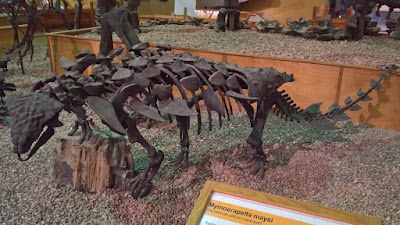New research on the systematic position of the enigmatic thyreophoran dinosaur Paranthodon africanus
A new article, by Thomas Raven and Susie Maidment,
redescribes a very poorly known thyreophoran taxon, Paranthodon africanus
Broom 1910, from the Lower Cretaceous Kirkwood Formation of South Africa, that
has had uncertain taxonomical affinities since its discovery, in 1845. At the
time, it was the first dinosaur to be found in Africa. Since then, it has been
placed in different groups. Richard Owen (1876) identified it as
pareiasaur, Anthodon serranius, then Broom (1910) reassigned it as
the ankylosaur Palaeoscincus africanus, and then Nopcsa (1929) as the
stegosaur Paranthodon oweni. More recently, Peter Galton & Walter
Coombs (1981) agreed that the specimen is a member of the Stegosauria and
coined Paranthodon africanus.
The new research shows that the
phylogenetic positioning of P. africanus is highly labile and deeply
dependent on the chosen taxonomic exemplifier. The material is limited to a
left partial maxilla, premaxilla, nasal, and a dorsal vertebra. Therefore, additional
material is also needed to fully assess its place within Thyreophora. Nonetheless,
the authors conducted extensive phylogenetic analysis, comparing it with previous
phylogenetic trees, and concluded that, with the available data, the most likely
outcome is that P. africanus is indeed a stegosaur.
It is worth noting that one of the results of the analysis performed
in this study is an improved resolution of the ankylosaurian phylogeny and more
robust support of the previous analysis, by Arbour & Currie (2016), Arbour
et al. (2016), and Thompson et al. (2012).
Full article: Raven, T. J., and S. C. R. Maidment. 2018. The systematic position of the enigmatic thyreophoran dinosaur Paranthodon africanus, and the use of basal exemplifiers in phylogenetic analysis.
Arbour, V. M., and P. J.
Currie. 2015. Systematics, phylogeny and palaeobiogeography of the ankylosaurid
dinosaurs. Journal of Systematic Palaeontology, 14(5): 385-444.
Arbour, V. M., Zanno, L. E., and T. Gates.
2016. Ankylosaurian dinosaur palaeoenvironmental
associations were influenced by extirpation, sea-level fluctuation, and
geodispersal. Palaeogeography,
Palaeoclimatology, Palaeoecology, 449: 289-299.
Broom R. 1910. Observations on some specimens of South
African fossil reptiles preserved in the British Museum. Transactions of the
Royal Society of South Africa, 2(1): 19-25.
Galton, P. M., and W. P. Coombs. 1981. Paranthodon
africanus (Broom) a stegosaurian dinosaur from the lower cretaceous of
South Africa. Geobios, 14(3): 299-309.
Nopsca FB. 1929. Dinosaurierreste Aus
Siebenburgen V. Geologica Hungarica (Series Paleontology), 1: 1-76.
Owen, R. 1876. Descriptive and illustrated catalogue of the
fossil Reptilia of South Africa in the collection of the British Museum. Order
of the Trustees.
Thompson RS, Parish JC, Maidment SCR, Barrett PM. 2012. Phylogeny
of the ankylosaurian dinosaurs (Ornithischia: Thyreophora). Journal of Systematic Palaeontology,
10(2):
301-312.


Comments
Post a Comment